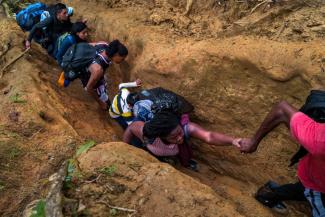Refugee routes
Why the US wants to close a jungle

According to recent reports, the US Department of Homeland Security has negotiated an agreement with the Colombian and Panamanian governments to prevent migrants from crossing the land bridge between the two countries. This is also to stop them from crossing the dangerous jungle in the border region (the Darién Gap, see main text) and would ultimately stop the increasing flow of people heading north to the US or Canada. The question is whether this US-brokered agreement is now driving a militarisation of the border.
While it can be argued that the presence of state armed forces can be helpful and necessary, it must not be forgotten that states must use other means than armed forces if they want to help migrants. Weapons are pointless. The crisis in the Darién Gap requires humanitarian assistance and support, as well as recognition of its causes and the inadequacy of current measures.
More income for human traffickers
Approaching the migrant crisis from a military perspective inevitably leads to the migrants being caught in the crossfire between armed forces and drug traffickers. As drug traffickers and gangs exert control over migrants crossing the border, it is likely that greater numbers of armed forces will lead to clashes as the gangs and traffickers seek to maintain their control over the illegal migration business and defend their drug trafficking routes. It will also lead to an increase in the income of human traffickers and mafia structures. They will only make crossing the Darién Gap more expensive given the higher costs of trafficking. This will also mean that migrants will try new (and more dangerous) routes, e.g. via the Caribbean or the Pacific Ocean.
Institutionalised migration channels need to be expanded more (such as the US government’s promised expansion of humanitarian entry permits). Such measures also enable the building of institutions capable of handling the increasing influx of people from other continents (mainly Asia and Africa).
African and Asian migrants accounted for 21,000 of the people crossing the Darién Gap in 2022. These include people from Senegal, India, Bangladesh, Nepal, Somalia and other countries. The migration of Africans and Asians through the Colombian jungle is a response to the lack of access of migrants to formal migration routes. It also shows the increasingly transnational character of flight and migration. The fact that this path is becoming more and more attractive for people from all over the world once again makes it clear how important it is to ensure that they can make a living and lead decent lives in their home countries.
Fabio Andrés Díaz Pabón is a researcher at the African Centre of Excellence for Inequality Research (ACEIR) of the University of Cape Town and a research associate at Rhodes University in South Africa.
diazpabon@iss.nl








